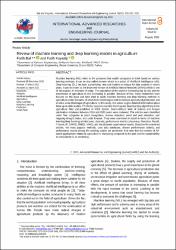| dc.description.abstract | Machine learning (ML) refers to the processes that enable computers to think based on variouslearning methods. It can be also called domain which is a subset of Artificial Intelligence (AI).Deep learning (DL) has been a promising, new and modern technique for data analysis in recentyears. It can be shown as the improved version of Artificial Neural Networks (ANN) which is oneof the popular AI methods of today. The population of the world is increasing day by day and theimportance of agriculture is also increasing in parallel. Because of this, many researchers havefocused on this issue and have tried to apply machine learning and deep learning methods inagriculture under the name of smart farm technologies both to increase agricultural production andto solve some challenges of agriculture. In this study, it is aimed to give detailed information aboutthese up-to-date studies. 77 articles based on machine learning and deep learning algorithms in theagriculture field and published in IEEE Xplore, ScienceDirect, Web of Science and Scopuspublication databases between 2016 and 2020 years were reviewed. The articles were classifiedunder five categories as plant recognition, disease detection, weed and pest detection, soilmapping-drought index, and yield forecast. They were examined in detail in terms of machinelearning/deep learning architectures, data sets, performance metrics (Accuracy, Precision, Recall,F-Score, R2, MAPE, RMSE, MAE), and the obtained experimental results. Based on the examinedarticles, the most popular methods, used data sets/types, chosen performance criteria, andperformance results among the existing studies are presented. It is seen that the number of AIbased applications related to agriculture is increasing compared to the past and the sustainabilityin productivity is so promising. | en_US |



















